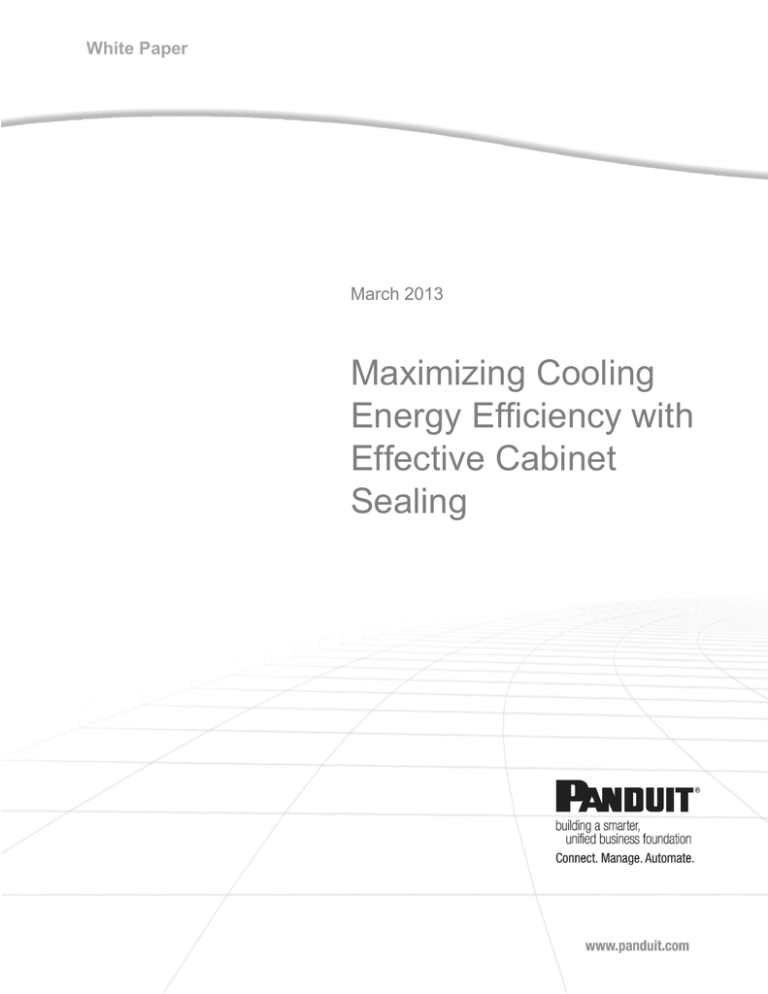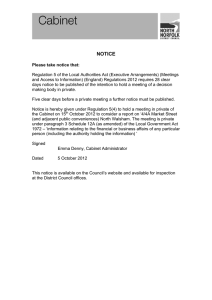
White Paper
March 2013
Maximizing Cooling
Energy Efficiency with
Effective Cabinet
Sealing
Maximizing Cooling Energy Efficiency with Effective Cabinet Sealing
Introduction
Driven by explosive growth in data processing demands, data center managers face multiple, competing
priorities: reducing operational costs, improving energy efficiency, and optimizing available capacity, all while
maintaining network availability/reliability. To meet these demands, data center space is often underutilized and
overprovisioned with power and cooling capacity.
A typical data center consumes an average of 5-7kW of power per cabinet. However, it also has individual
cabinets or zones with significantly higher thermal loads. This can lead to overcooling of the entire data center
and an inflation in energy costs.
Anticipating the impact of the trend toward higher densities, data center managers are increasingly using air
containment systems to manage higher thermal loads. In an air-cooled data center, containment systems are
used to effectively separate cold air from hot exhaust air to reduce the cooling system energy consumption.
Containment systems such as cold aisle containment and hot air containment (vertical exhaust ducts) prevent
mixing of cold and hot air streams and enable cooling system energy savings of up to 40%. This allows chillers
to operate more efficiently, which reduces energy consumption. A properly sealed cabinet is critical to obtaining
this level of energy efficiency savings and achieving maximum cooling system performance with a containment
system.
Space utilization can also be improved by utilizing cabinets and containment systems that optimize the
separation of hot and cold air. Cabinets can be provisioned for thermal loads of 15kW or more per cabinet if
power and cooling are managed effectively. As energy and construction costs continue to rise, overprovisioning and under-utilization are no longer sustainable and result in higher operating expense (OpEx) and
capital expense (CapEx).
This white paper compares air leakage characteristics for three Vertical Exhaust Duct (VED) cabinets (a type of
hot air containment) from different manufacturers and explains how the difference in sealing level between
Panduit’s Energy Efficiency Cabinet System and these competitors’ cabinets translates into energy reductions
that result in OpEx savings of as much as $780USD per cabinet per year while enabling densities of 15kW and
higher per cabinet.
Cabinet Leakage Challenge
Leakage is air that escapes through structural gaps and holes between and through mounting rails, cable
management devices, blanking panels, and equipment. Cabinet leakage can adversely affect thermal efficiency
by increasing cooling energy usage and its associated costs. In a Cold Aisle Containment (CAC) system,
leakage paths can result in cold air bypass whenever a sufficient pressure differential exists between the cold
aisle and the hot aisle side of the containment system. The bypassed cold air mixes with the cabinet exhaust air
and reduces the cooling unit return air temperature and its efficiency. In a VED cabinet, leakage paths can allow
recirculation of hot exhaust air whenever there is a pressure differential that forces the hot exhaust air through
the various gaps into the cold aisle. The recirculated hot exhaust air warms the cold aisle air to a temperature
above the targeted room set point and can force the data center operator to lower the room set point
temperature to maintain the desired equipment inlet temperature.
This type of recirculation within the cabinet is different from the row-level recirculation where hot aisle air
recirculates to the IT equipment inlet over the top of the cabinet or around the end of a row, common in
traditional hot/cold configurations. The net result is the same – higher inlet air temperatures. However, while
RKAT01--WW-ENG, Rev.0, 03/2013
©2013 Panduit Corp. ALL RIGHTS RESERVED.
2
Maximizing Cooling Energy Efficiency with Effective Cabinet Sealing
containment solutions eliminate the room and row level recirculation issues, they do not eliminate in-cabinet
recirculation. One way to reduce the effect of cabinet air leakage is to use fan-assisted VEDs but this solution
increases the complexity of the data center airflow design and has higher initial costs, making it less efficient
than passive approaches. It also increases the points of failure and the overall data center cooling energy cost.
A simpler solution is to effectively seal all the gaps, holes and openings that can result in air leakage in a
cabinet structure.
To minimize air leakage in the cabinet, Panduit’s new energy-efficient cabinet system is engineered to
completely separate hot exhaust air from cold supply air, which allows higher data center set points, resulting in
reduced cooling energy usage. Panduit’s new cabinet design eliminates gaps other than those needed to mount
equipment. For example, the Net Access™ S-Type cabinet improves separation between cold and hot air over
the previous generation server cabinet by closing gaps within the cabinet structure. An innovative vertical post
design, in conjunction with integrated air dams block potential leakage paths between the front and back of the
cabinet. Externally attached door hinges and door latch brackets reduce the number of large openings in the
frame posts through which air can escape. Plugs designed especially for unused openings also contribute to the
improved air sealing. This attention to detail gives S-Type cabinets an advantage in thermal efficiency over
earlier generation server cabinets.
VED Cabinet Thermal Testing
To quantify the benefit of improved sealing at the cabinet level, a series of thermal and airflow tests was
completed on the Net Access™ S-Type VED cabinet and on two other VED cabinets from different
manufacturers.
This section describes cabinet leakage testing for three cabinets and shows how poor sealing results in higher
IT equipment inlet temperatures, an effect that gets worse as the cabinet heat load and airflow increase. This
difference is then translated into energy savings and OpEx savings.
The objective of the testing was to quantify the effects of improved cabinet sealing for a VED version of a Net
Access™ S-Type (600mm x 45RU x 1200mm) cabinet against competitor A (600mm x 42RU x 1200mm) and
competitor B (600mm x 48RU x 1200mm) VED cabinets. Each cabinet was tested individually.
First, we performed flow bench tests to characterize the air leakage through the three cabinets. These tests
were done with an airflow test chamber (AMCA 210-99) setup that pulled air through the front of the cabinet.
All three cabinets were set up for the airflow leakage test in a similar manner, see Figure 1. Next, the front door
was removed and the cabinet adapter assembly was attached to the flow bench, and sealed to the front
external edges of the cabinet. Finally, the equipment mounting space (between the mounting rails) was sealed.
The airflow testing over a range of pressures (0.005”-0.7” H2O) showed significant differences in the level of
sealing among the three cabinet manufacturers. The Net Access™ S-Type cabinet allowed on an average 20%
less air leakage over a wide range of pressure differences than the competitor cabinets, as shown in Figure 2.
RKAT01--WW-ENG, Rev.0, 03/2013
©2013 Panduit Corp. ALL RIGHTS RESERVED.
3
Maximizing Cooling Energy Efficiency with Effective Cabinet Sealing
Cabinet adapter to
airflow test chamber
Cabinet under
test
AMCA 210-99
Figure 1. Airflow testing setup. From left to right: the cabinet under test (black) cardboard adapter,
cabinet adapter to airflow test chamber (white) and AMCA 210-99 (blue).
1400
Airflow (cfm)
1200
1000
800
600
400
200
0
0.00
0.20
Competitor A
0.40
0.60
0.80
Static Pressure (in. w.g.)
Competitor B
Net Access S Type
Figure 2. Flow bench test results showing cabinet leakage data.
To quantify the effect of cabinet leakage on data center efficiency, we tested all three cabinets in the Panduit
thermal lab. We increased the cabinet IT load from 15 kW to 33 kW and observed the resulting elevated inlet
temperatures caused by hot air recirculation through leaks.
The data center test lab is equipped with a Computer Room Air Handler (CRAH) that delivers cold air to a
raised floor plenum that distributes the air to the test cabinet through perforated tiles. Each test cabinet was set
up per the manufacturer’s standard VED configuration. The tests were run with a supply air temperature of 68°F
(20°C). Three to four perforated tiles were used, depending on the cabinet heat load and airflow requirements,
as shown in Figure 3, top view. This was done to minimize the upward velocity of air supplied by tiles and to
minimize the variation in under-floor pressure. The drop ceiling return plenum was maintained at approximately
-0.02 inches of water. A total of three HP Proliant DL360 G5 servers were installed, one in the bottom, middle,
and top RU locations, respectively, to study the effect of back pressure on server fans, if any. Four thermal load
banks were placed between the servers to simulate additional IT equipment heat and airflow, see Figure 3, front
RKAT01--WW-ENG, Rev.0, 03/2013
©2013 Panduit Corp. ALL RIGHTS RESERVED.
4
Maximizing Cooling Energy Efficiency with Effective Cabinet Sealing
view. Any open RU slots were filled with horizontal blanking panels and servers were operated at maximum
power dissipation via burn-in code for all tests. The load banks generated sufficient heat load to represent a
range of cabinet heat dissipations from 15 kW to 33 kW with an airflow rate of 100 cfm/kW. For each of the
scenarios the CRAH supplied 10% more airflow than the cabinet airflow demand. Several temperature and
pressure sensors were installed to capture the cabinet inlet/exhaust temperature profile and pressure
distribution at the back of the cabinet.
Top Server
Middle Server
Load bank
Bottom Server
Top view of the Lab Space
Cabinet Front View
Figure 3. Data center test lab setup. From left to right: top view of the lab, cabinet front view showing
the location of the load banks and the servers.
Thermal Testing Results
The results of the thermal testing are displayed as a thermal map (Figure 4) on the face of the cabinets. The
thermal map provides a visualization of the inlet air temperature gradients resulting from in-cabinet exhaust air
recirculation. In the Net Access™ S Type VED cabinet the maximum inlet air temperatures were all at least 1ºC
below the ASHRAE recommended inlet temperature limit of 27ºC. However, due to in-cabinet recirculation the
maximum inlet air temperatures on competitor cabinets were higher than the ASHRAE recommended limit
(11ºC for competitor A and 6ºC for competitor B). With this configuration, the Net Access™ S Type VED cabinet
can support a heat load of up to 33 kW and airflow up to 3300 cfm. Note that Panduit’s new cabinet, because of
the superior sealing, did have slightly higher back pressure versus one of the competitor cabinets, but its effect
on the server fans was minimal. In fact, higher server inlet air temperature and higher server fan speeds were
observed in the competitor cabinets.
RKAT01--WW-ENG, Rev.0, 03/2013
©2013 Panduit Corp. ALL RIGHTS RESERVED.
5
Maximizing Cooling Energy Efficiency with Effective Cabinet Sealing
Net Access S Type
Competitor A
Competitor B
15kW
20kW
25kW
30kW
33kW
Figure 4. Comparison of inlet air temperature gradients at front of cabinets.
Energy Savings and Economic Analysis
Various data center containment solutions have flooded the market with claims of energy efficiency
improvements designed to offset the additional first costs of the containment systems installation. The
effectiveness of a containment system is determined by its ability to prevent hot air recirculation and cold air
bypass. Containment systems can allow improvements in energy efficiency if cooling system set points can be
modified. The magnitude of these energy savings depends on the degree to which the containment system is
sealed.
From the collected data, a potential energy savings due to the Total Air Seal feature was calculated. Preventing
hot exhaust air recirculation allows the room supply air temperature to be increased without exceeding
ASHRAE limits at the IT equipment. This, in turn, allows the data center operator to increase the building chilled
water temperature (assuming cooling is provided by a mechanical cooling system with a chiller). The efficiency
of a chiller system increases with an increase in chilled supply water temperature (SWT). As a rule of thumb, for
every degree Celsius increase in SWT the chiller efficiency increases by 3%-4% 2 A hypothetical data center
layout with a chiller based cooling system was used to estimate the potential cooling energy savings. We
extrapolated the 20 kW single cabinet thermal test data to a 1.6 MW data center with multiple cabinets, resulting
in 41% less cooling energy consumed.
RKAT01--WW-ENG, Rev.0, 03/2013
©2013 Panduit Corp. ALL RIGHTS RESERVED.
6
Maximizing Cooling Energy Efficiency with Effective Cabinet Sealing
Table 1. Economic analysis with 20kW per cabinet.
Example Data Center Characteristics
Total IT Load (kW)
1600
Number of Cabinets
80
Per Cabinet IT Load (kW)
20
Centrifugal Chiller System
0.67 kW/Ton @ 5.6°C SWT, SWT
can be raised up to 18°C
Table 1 shows the results of the economic analysis with 20 kW per cabinet. Here, the ASHRAE allowable inlet
air temperature limit of 32°C is used as a threshold for the IT equipment inlet air, which then determines the
maximum supply air temperature (SAT). Similar to the single cabinet thermal tests, we assumed 10% excess
facility cooling airflow beyond the cabinet airflow demand. Also, it has been assumed that the IT equipment inlet
air temperature scales up and down linearly with the supply air temperature. For example, a 6.5°C decrease in
supply air temperature would lower the maximum IT equipment inlet air temperature by 6.5°C. The cooling
chain components (such as CRAH units, fixed flow rate pumps, cooling tower, etc.) that are fixed for all three
cabinet scenarios are not considered in the analysis. The improvement in cooling allows significant cooling
energy cost savings, as shown in Table 2.
Table 2. Chiller Annual Energy Cost Comparison for 20 kW VED cabinets
Experimental Supply Air Temp., Deg. C
Experimental Maximum IT Inlet Air Temp., Deg. C
SAT to maintain max IT inlet of 32°C, Deg. C
SWT (assuming 7.2°C approach), Deg. C
Chiller Annual Power Consumption (kW)
Chiller Annual OpEx ($0.10 per kWh)
% Increase in Annual Chiller Energy Usage
Annual Savings per Cabinet over Competitor B
Competitor A
Competitor B
20
33.4
18.8
11.6
237
$207, 811
39%
20
33.7
18.5
11.3
241
$211,182
41%
Panduit Net
Access S
Type
20
27
25
17.8
170
$148,859
baseline
$780
Figure 5 shows the comparison of chiller annual energy costs for the different heat load scenarios (assuming
that the total data center IT load remains ~1.6MW).
RKAT01--WW-ENG, Rev.0, 03/2013
©2013 Panduit Corp. ALL RIGHTS RESERVED.
7
Chiller Annual Energy Cost
Maximizing Cooling Energy Efficiency with Effective Cabinet Sealing
$260,000
$240,000
$220,000
$200,000
$180,000
$160,000
$140,000
$120,000
15kW 20kW 25kW 30kW 33kW
Competitor A
Competitor B
Net Access S Type
Figure 5. Chiller Annual Energy Cost Comparison for different heat load VED cabinets.
For data centers with an economizer system (airside or waterside), a higher room air set point temperature
allows more hours of free cooling, and therefore reduced cooling energy. For example, a data center located in
Chicago with an airside economizer that can be operated with 25°C supply air would be able to use free cooling
for 88% of the time (~7700 hours out of 8760 hours) in a year2, which translates to approximately $156,000 in
annual cooling energy savings (for a 1.6MW data center) over a chiller based cooling system
Conclusion
Through airflow bench testing we have demonstrated that the integral cabinet sealing features of Panduit’s Net
Access™ S Type VED cabinet reduce air leakage by up to 20% over the competitors’ cabinets. The improved
sealing has a significant impact on hot air recirculation and IT equipment inlet temperatures, as the VED cabinet
IT loads increase from 15 kW to 33 kW. This study clearly demonstrates the economic benefit of using a wellsealed cabinet in containment applications.
References
1.
Average Data Center Energy Usage Allocation, Lawrence Berkeley National Laboratory 2007
2.
Design Considerations for Datacom Equipment Centers ASHRAE 2009, Second Edition. Page 138.
About Panduit
Panduit is a world-class developer and provider of leading-edge solutions that help customers optimize the
physical infrastructure through simplification, increased agility and operational efficiency. Panduit’s Unified
Physical Infrastructure℠ (UPI)-based solutions give enterprises the capabilities to connect, manage and
automate communications, computing, power, control and security systems for a smarter, unified business
foundation. Panduit provides flexible, end-to-end solutions tailored by application and industry to drive
performance, operational and financial advantages. Panduit’s global manufacturing, logistics, and e-commerce
capabilities along with a global network of distribution partners help customers reduce supply chain risk. Strong
technology relationships with industry leading systems vendors and an engaged partner ecosystem of
consultants, integrators and contractors together with its global staff and unmatched service and support make
Panduit a valuable and trusted partner.
www.panduit.com · cs@panduit.com
RKAT01--WW-ENG, Rev.0, 03/2013
©2013 Panduit Corp. ALL RIGHTS RESERVED.
8



